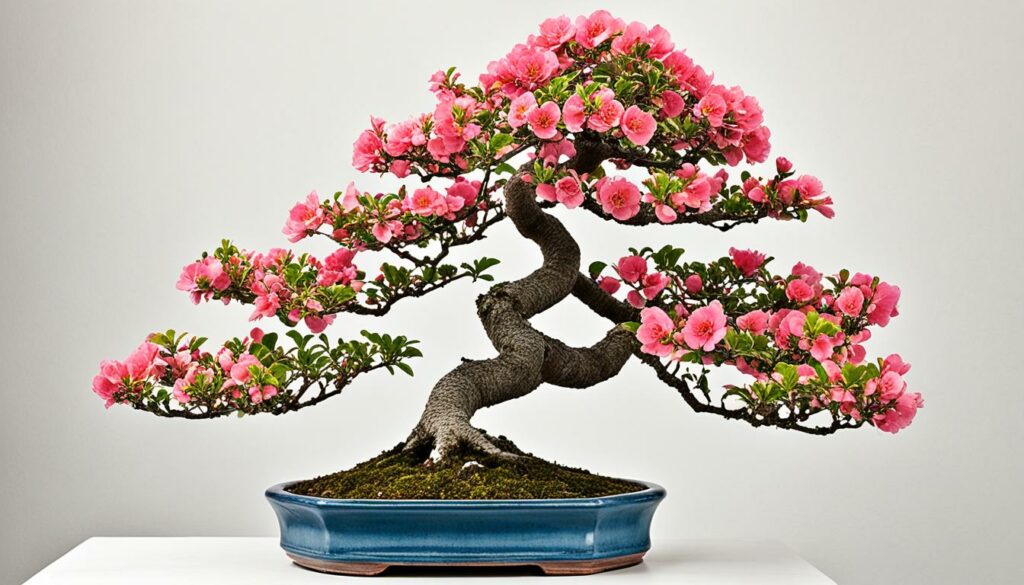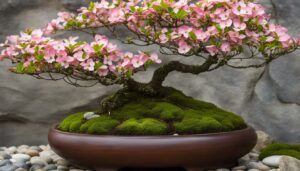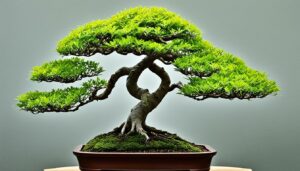If you’re looking for a unique and beautiful addition to your bonsai collection, the Chinese Quince is a must-have. This colorful and visually striking bonsai tree species is known for its year-round vibrancy and appeal. Whether you’re an experienced bonsai enthusiast or just starting, the Chinese Quince is a great choice that is sure to impress.
Key Takeaways:
- The Chinese Quince is a vibrant and colorful bonsai tree species.
- The Chinese Quince is ideal for bonsai cultivation due to its unique features.
- Proper care and maintenance are key for promoting healthy growth and encouraging abundant flowering.
- Styling and shaping techniques can help create a visually appealing bonsai tree.
- Displaying and enjoying your Chinese Quince bonsai is an art in itself.
Understanding Chinese Quince Bonsai
Chinese Quince bonsai, or Pseudocydonia sinensis, is a unique and visually stunning tree species that makes an excellent addition to any bonsai collection. With its attractive bark, delicate flowers, and deciduous leaves, Chinese Quince stands out as an elegant and vibrant choice for bonsai enthusiasts.
| Botanical Name | Pseudocydonia sinensis |
|---|---|
| Origins | Native to China and cultivated extensively in Japan and Korea. |
| Growth Habits | Slow-growing with a gnarled, twisted trunk and elliptical-shaped leaves. Typically reaches a height of up to 20 feet in the wild, but can be trained to much smaller sizes as a bonsai. |
| Unique Features | Produces delicate pink or red flowers in late spring, followed by small yellow fruits in the fall. Bark has a distinctive orange-peel texture. |
The Chinese Quince bonsai is known for its resilience and ability to adapt to a wide range of growing conditions, making it an excellent choice for bonsai growers of all skill levels. With proper care and maintenance, Chinese Quince can live for several decades and bring beauty to your home or garden year-round.
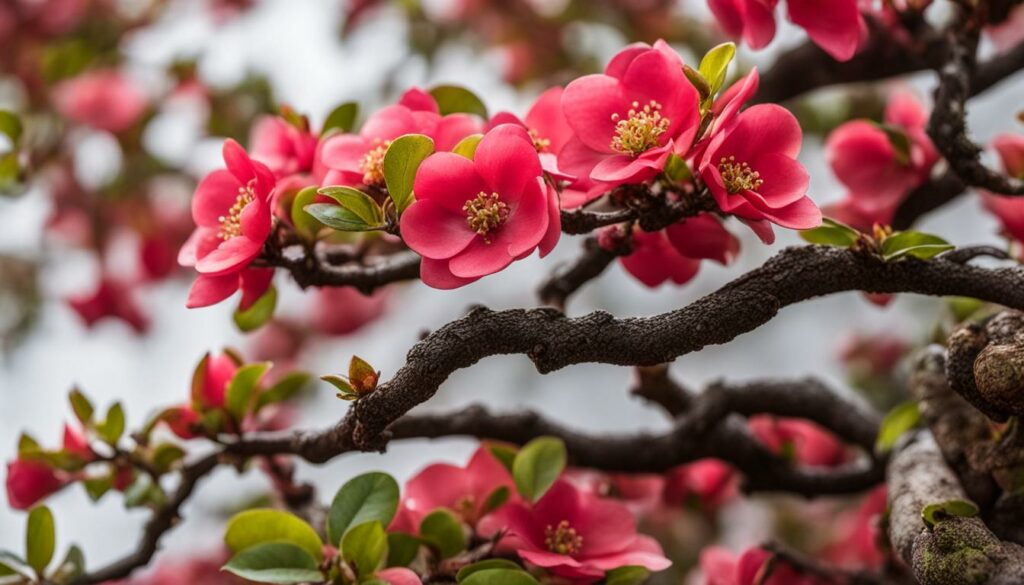
Cultivating Chinese Quince Bonsai
Successfully cultivating Chinese Quince bonsai requires specific attention to several key requirements. Below are the basics of growing a robust and vibrant Chinese Quince bonsai tree.
Soil Requirements
Chinese Quince bonsai trees prefer well-draining soil with a mix of organic and inorganic matter. A suitable bonsai soil mix can comprise of Akadama, pumice, and lava rock. Avoid using heavy potting soil that can compact and lead to stagnant water, which may damage the roots.
Watering Requirements
Chinese Quince bonsai trees require a consistent watering schedule. Ensure the soil is moist and never dries out completely. However, beware of overwatering, which can lead to root rot. Watering needs can differ from season to season, so monitor the soil carefully.
Light Exposure Requirements
Chinese Quince bonsai trees need full sunlight. Ensure that the tree is positioned in an area that receives abundant natural light. Supplementation with grow lights or natural light through windows is crucial in regions with shorter days and less sunlight in winter.
Temperature Requirements
Chinese Quince bonsai trees require a cool winter dormancy period. Protect the tree from extreme cold and frost by positioning it in a protected location or wrapping it in insulation materials. Moreover, provide ample ventilation and avoid exposing the tree to hot, dry air, or drafts.
Pruning Techniques
Chinese Quince bonsai trees require regular pruning to encourage branch ramification and maintain its shape. Use sharp pruning shears and wire to train the tree and remove unwanted growth. Regular pruning helps increase flower bud production and maintain healthy foliage.
With the right attention to soil, watering, light exposure, and pruning techniques, growing a beautiful flowering Chinese Quince bonsai tree can be a rewarding experience.
Styling Chinese Quince Bonsai
Chinese Quince bonsai can be styled in various ways to create a visually appealing bonsai tree. The formal upright style is suitable for beginners. The trunk should be straight, and the branches should alternate on opposite sides of the trunk, creating a symmetrical structure. In contrast, slanting style conveys a sense of age and struggle. The trunk should be slanted at a 45-degree angle, and branches should grow outward, creating a sense of movement. For cascading style, the branches should grow downward, emphasizing the artistry of the trunk’s curvature.
When wiring Chinese Quince bonsai, ensure that the branches are not too tight, which could damage the bark. First, wrap the wire closely around the branch, then twist the wire, so it creates a gentle bend. When the wire is removed, the branch will retain its shape. Shape the wire so that it is not visible, detracting from the tree’s aesthetic appeal.
Shaping Chinese Quince bonsai involves pruning the tree’s branches and foliage. The objective is to create a well-proportioned tree and promote growth in certain areas. Pruning should only be done after flowering to avoid losing the next year’s flowers. With gentle, precise cuts, trim the side branches and shoots to maintain balance and shape.
Creating a visually appealing bonsai tree takes time and effort, but it is worth it when you see the results. Keep in mind that your Chinese Quince bonsai’s styling should complement its unique features, such as its peeling bark and fragrant flowers. With the right styling techniques, you can create an unforgettable bonsai tree to enjoy for years to come.
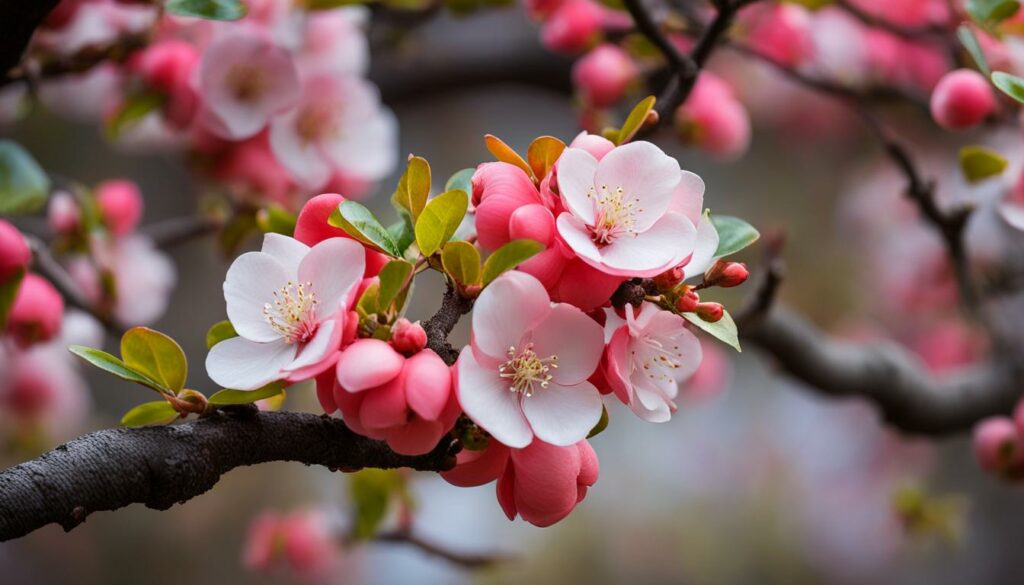
Pruning and Wiring Chinese Quince Bonsai
To ensure that your Chinese Quince bonsai tree maintains its desired form, regular pruning and wiring techniques are essential. These techniques are used to achieve a specific shape, size, and overall look for your bonsai, making it more visually appealing.
Pruning Techniques:
Pruning is the process of removing unwanted or excess growth on the tree, including branches, foliage, and even roots. It is necessary to promote healthy growth and shape the tree. Customers should prune their Chinese Quince bonsai tree in the early spring or late winter, before the tree starts to produce new growth. This will allow time for the plant to recover before the start of the growing season.
The following are the widely-used pruning methods:
- Regular Pruning: Regular pruning is performed throughout the year to maintain the shape and size of the tree.
- Thinning: Thinning is performed to reduce the density of the foliage and open up the canopy to allow more light to reach the inner branches and buds.
- Pinching: Pinching is mainly performed to create more compact foliage pads, increase branching, and redirect the growth.
- Defoliation: Defoliation is the process of removing all the leaves from the tree. This is usually performed to balance vital energy between roots and branches, and to promote new growth and bud formation.
Wiring Techniques:
Wiring is the process of wrapping wire around branches to bend and shape them in the desired direction. It should be done sparingly and with care, as wiring techniques can damage the tree if done incorrectly. Customers should wire their Chinese Quince bonsai before spring begins, between February and April, or in the fall, between September and November, when the tree is dormant.
The following are the widely-used wiring methods:
- Clip and Grow: This is a method of wiring that involves clipping the leader to the desired height and wiring the branches to create the desired shape.
- Branch Replacement: This method involves cutting away an unwanted branch and wiring the new branch that will take its place into the desired position.
- Thread and Raffia: This method involves using a flexible wire to wrap around the branch, and then using medical adhesive tape or raffia to hold the wire in place. It is useful for bending larger branches or trunks that cannot be bent with ordinary wire.
By using these techniques, customers can cultivate and style their Chinese Quince bonsai to create a visually appealing, healthy, and thriving tree.
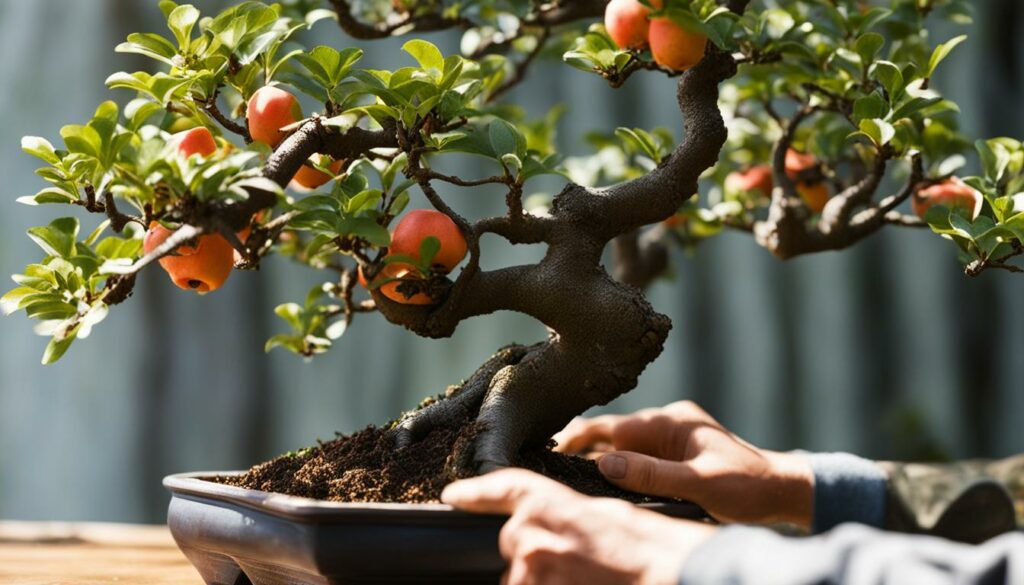
Caring for Flowering Chinese Quince Bonsai
During the flowering season, your Chinese quince bonsai requires specific care for optimal growth and health. Maximize its beautiful floral display and protect it from pests and diseases with these essential tips:
- Watering: The Chinese quince bonsai’s soil should be kept moist but not saturated. Water it thoroughly, and wait for the soil surface to dry slightly before watering again. Avoid overwatering, which can lead to root rot.
- Fertilizing: Regularly feed your bonsai with a balanced fertilizer to support healthy growth and flowering. Use a low nitrogen fertilizer during the flowering season.
- Pruning: Deadhead spent flowers to promote continuous blooming and prevent the bonsai from wasting energy on developing seeds. Prune damaged or diseased branches regularly.
- Pest and disease control: Keep an eye out for common pests, such as spider mites and scale insects, and treat with an appropriate pesticide. Prevent common diseases like powdery mildew by avoiding overwatering and promoting proper air circulation around the tree.
To keep your Chinese quince bonsai flourishing, it’s essential to maintain its overall health and vitality. Always remain attentive to its unique needs throughout the year.
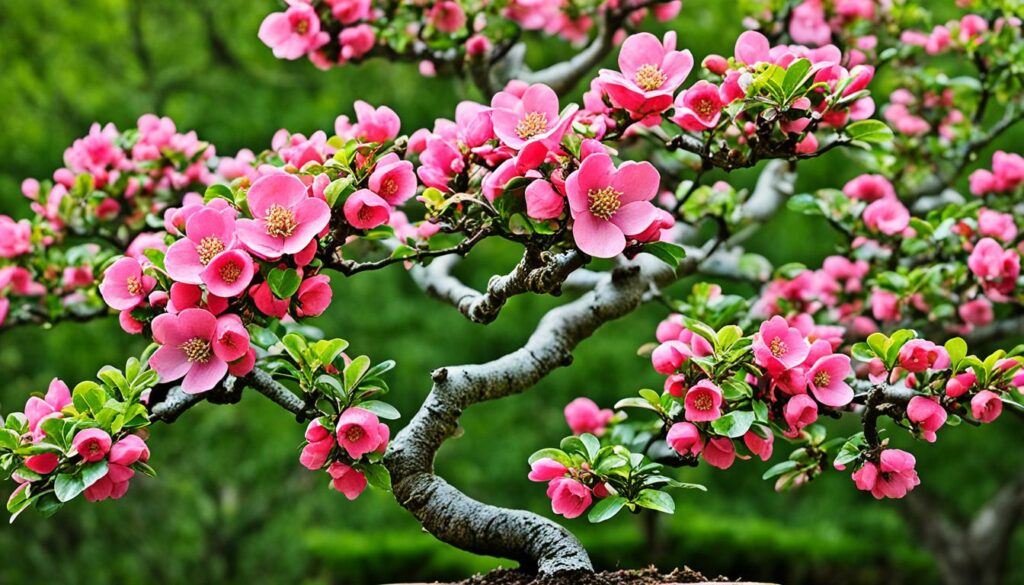
Displaying and Enjoying Chinese Quince Bonsai
Caring for your Chinese Quince bonsai also includes proper display and appreciation. The right container and position can enhance the aesthetic appeal of your bonsai and allow you to enjoy its beauty year-round.
Container Selection
Choose a container that complements the beauty of your Chinese Quince bonsai. Consider the color, size, and design to create a harmonious and visually appealing display. Ceramic containers are a popular choice, as they provide stability, insulation, and an elegant appearance.
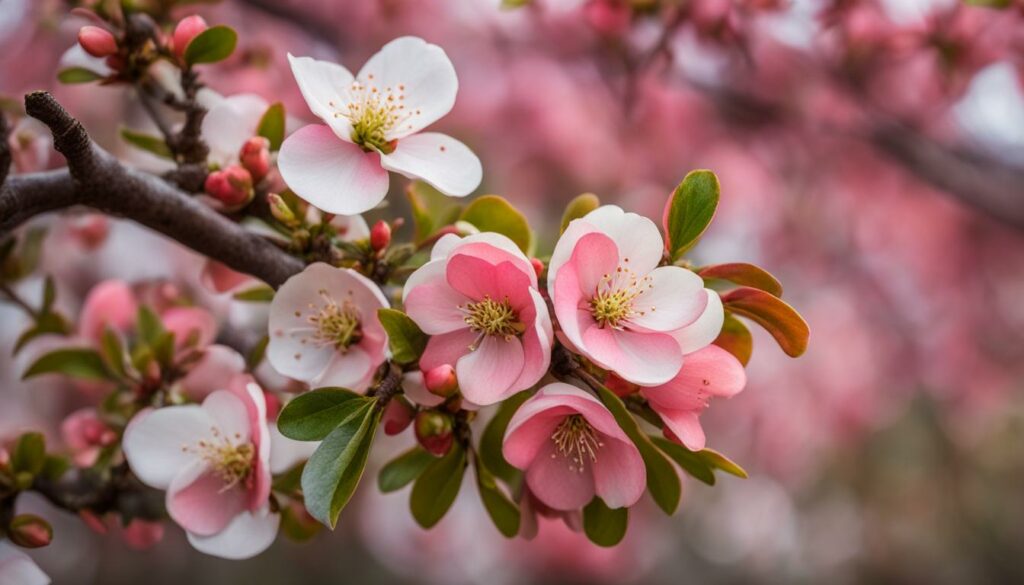
Positioning
Place your Chinese Quince bonsai in a spot with the right amount of light and temperature. The ideal spot is where it can receive partial sunlight and partial shade, as too much or too little light can affect its growth and flowering. It also needs to be protected from extreme temperatures, as it prefers a temperate climate.
The Art of Appreciation
The beauty of your Chinese Quince bonsai is not only in its vibrant flowers but also in its overall shape and form. Take time to appreciate its unique characteristics and enjoy the art of bonsai cultivation. This involves observing the tree closely, exploring its different angles and features, and contemplating the different interpretations that its form can evoke.
Conclusion
Having learned about the captivating nature of Chinese Quince bonsai, you now have an opportunity to explore this unique Bonsai Tree Species. Pseudocydonia, or Chinese Quince, is a vibrant and appealing flowering bonsai that can be enjoyed throughout the year. Understanding its distinctive characteristics and requirements for cultivation can help you create a visually striking bonsai tree.
By following proper care instructions, including soil, watering, light exposure, temperature, pruning, and wiring techniques, you can enhance the health and vitality of your Chinese Quince bonsai and promote abundant flowering. You can also maximize the aesthetic appeal of your tree by exploring various styling techniques, such as formal upright, slanting, or cascading styles.
With the right container and positioning, your Chinese Quince bonsai can bring joy and beauty to your home or garden. So go ahead and give Pseudocydonia a try; you won’t be disappointed by this enchanting Bonsai Tree Species.
FAQ
What is the Chinese Quince bonsai?
The Chinese Quince bonsai, also known by its botanical name Pseudocydonia, is a vibrant and appealing bonsai tree species that can be enjoyed year-round for its beautiful flowers.
What are the characteristics of the Chinese Quince bonsai?
The Chinese Quince bonsai has small, glossy green leaves and produces stunning pink or white flowers in the spring. It has an attractive bark that peels, adding to its visual appeal.
How do I cultivate Chinese Quince bonsai?
To successfully cultivate Chinese Quince bonsai, make sure to provide well-draining soil, water it regularly but avoid overwatering, expose it to bright but indirect light, maintain a temperature between 50-75°F (10-24°C), and prune it to shape and promote growth.
What are some styling techniques for Chinese Quince bonsai?
Chinese Quince bonsai can be styled in various ways, such as the formal upright, slanting, or cascading styles. Wiring and shaping techniques can be used to create a visually appealing bonsai tree.
How do I prune and wire a Chinese Quince bonsai?
Regular pruning is essential for maintaining the desired form of a Chinese Quince bonsai. Wiring techniques can also be used to shape the tree. It is best to perform these tasks during the tree’s dormant period in late winter or early spring.
How do I care for a flowering Chinese Quince bonsai?
When caring for a flowering Chinese Quince bonsai, ensure it receives adequate sunlight, water it regularly, and fertilize it during the growing season. Protect the tree from pests and diseases, and remove any spent flowers to encourage new blooms.
How should I display and enjoy a Chinese Quince bonsai?
Display your Chinese Quince bonsai in a suitable container and position it where it can be appreciated for its aesthetic appeal. Take time to observe and appreciate the beauty of the flowering bonsai throughout the year.
